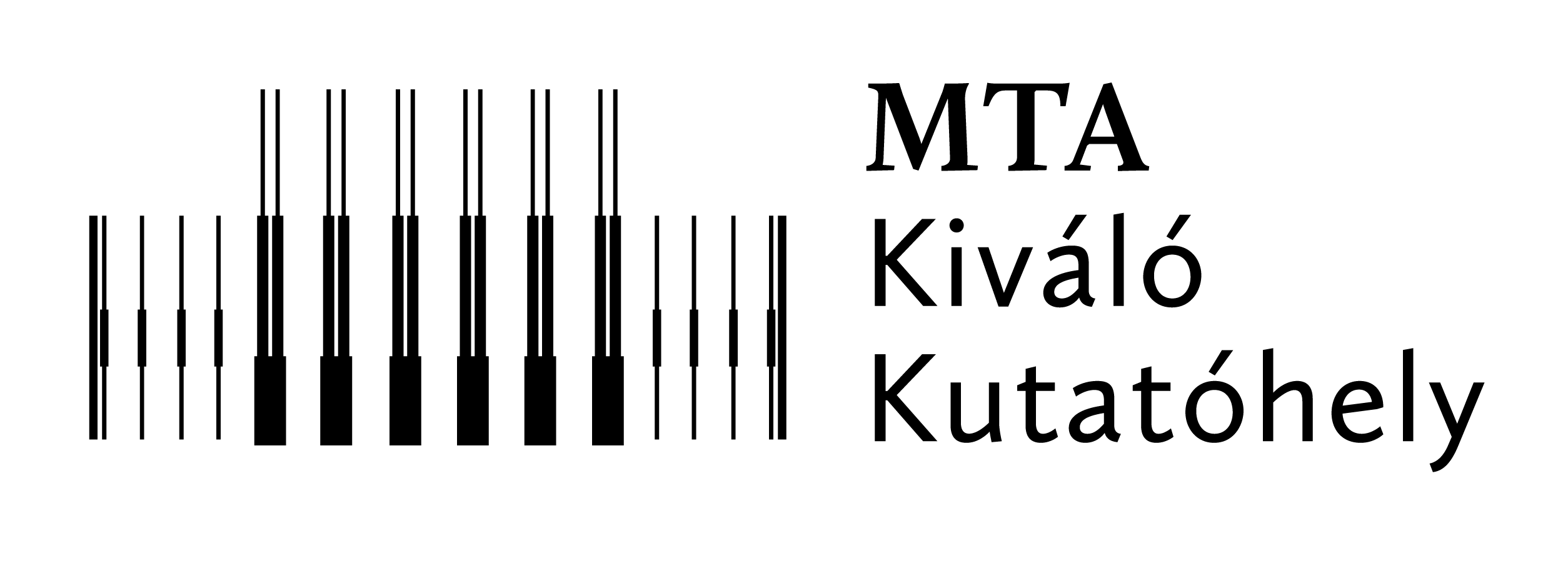2018
We developed a particle-based simulation code for the description of short-pulsed (~ns) discharges at atmospheric pressure helium gas with an admixture of molecular nitrogen (at concentrations ≤1%). In this code, we have also included the photon treatment of the VUV resonance radiation of helium. We have explored the spatiotemporal evolution of charged species densities, reaction rates, and the fluxes of ”active” species at the surfaces. We have investigated, as well, the behaviour of the electron velocity distribution function and the electron energy probability function, and concluded that these deviate significantly from the Maxwell-Boltzmann distribution, especially in the cathode region of the discharge. These observations demonstrated the usefulness (and uniqueness) of particle simulations of similar physical systems. We have found that the VUV resonance radiation of He atoms is heavily trapped within the high-pressure gaseous environment and photons are absorbed / re-emitted typically several hundred times before leaving the plasma. Nonetheless, the escaping photons were found to contribute significantly to the electron emission process at the electrodes. For most conditions studied, an increase of around a factor of two of the current pulse peak was observed when VUV photons were included in the simulations, in comparison to those cases when their effect was neglected. The figure shows results for a plane-parallel electrode configuration with a gap of 1 mm, to which a high voltage pulse with an amplitude of 1000 V is applied, with a trapezoidal shape. Current pulses in the order of 10 A are generated over the electrode surface of 1 cm2, when VUV photons are not considered in the simulation (at an initial charged particle density of 1.5×1011 cm−3). The peak current grows to ~20 A, when VUV photons are included. The figure also shows the time integrated wavelength-resolved radiation from the plasma, in the vicinity of the theoretical wavelength of the 21P → 11S resonant transition.
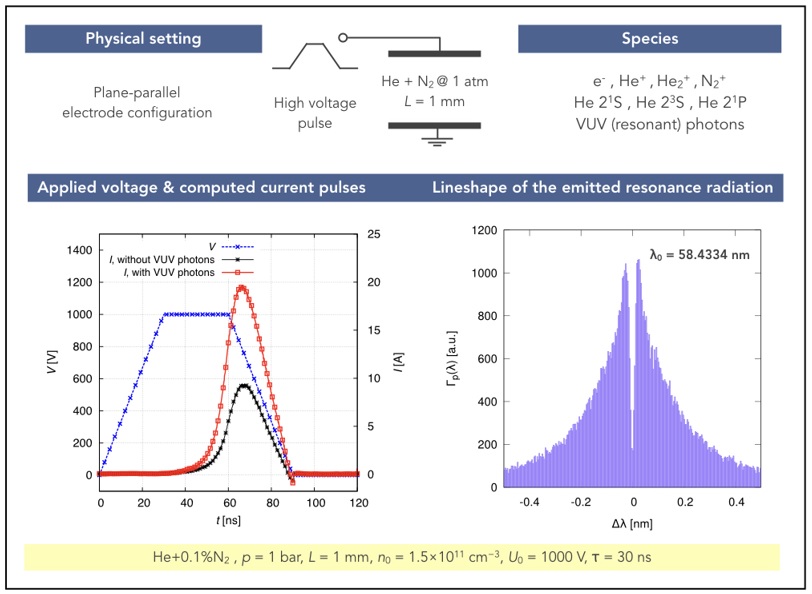
We have performed systematic investigation of the influence of various surface processes - such as the secondary electron (SE) emission induced by ions and electrons, and electron reflection at the electrodes - on the discharge characteristics in low-pressure capacitively coupled radiofrequency discharges. By using a realistic (energy-dependent) model for the description of the electron-surface interaction in our Particle-in-Cell/Monte-Carlo Collisions (PIC/MCC) simulation code, we have studied the effect of the electron-induced SEs on the discharge characteristics in the 0.5 Pa–3 Pa pressure range, for voltage amplitudes between 100 V–1500 V, assuming different SE yields for ions (γ–coefficient). Such discharge conditions are typical in industrial applications, such as plasma etching, sputtering and plasma immersion ion implantation. We demonstrated that the realistic description of the electron-surface interaction significantly alters the computed plasma parameters, compared to results obtained based on a simple model (which completely neglects the emission of SEs due to electron impact) for the description of the electron-surface interaction, widely used in PIC/MCC simulations of low-pressure capacitively coupled plasmas.
We have found that both the gas pressure and the value of the γ-coefficient affect the role of electron induced SEs (δ-electrons) in shaping the discharge characteristics at different voltage amplitudes. Their effect on the ionization dynamics has been found to be most striking at low pressures, high voltage amplitudes and high values of the γ-coefficient (see Figure 1). At low pressures, the energetic ion-induced SEs (γ -electrons) generated at one electrode and accelerated towards the bulk by the local sheath electric field, can cross the bulk without collisions and generate a high number of electron-induced SEs (δ-electrons) upon their impact at the opposite electrode. Depending on the instantaneous local sheath voltage, these δ-electrons are accelerated into the plasma bulk, where they generate significant ionization and enhancement of the plasma density. On the other hand, at high pressures due to the more frequent collisions, the electrons reach the electrodes at lower energies, which leads to a decrease of the number of SEs emitted by electron impact at the electrodes, therefore, to a decrease of the contribution of δ-electrons to the ionization.
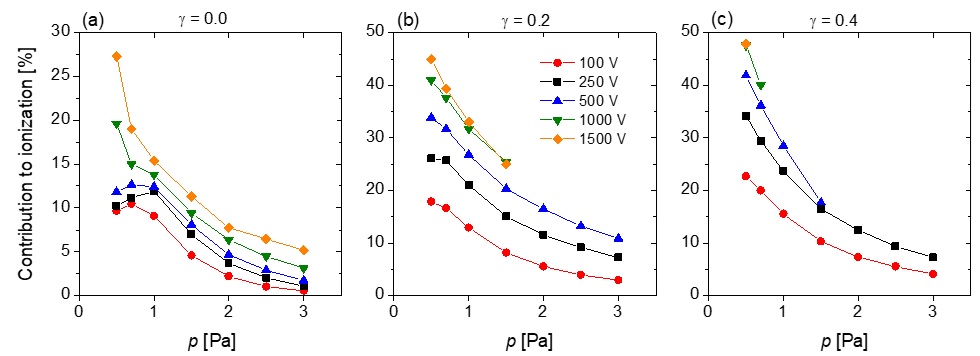
Figure 1. Contribution of electron-induced secondary electrons (δ-electrons) to the total ionization at different pressures and voltage amplitudes, for different values of the ion-induced secondary electron emission coefficent, γ.
Dusty plasmas –
In the field of dusty plasma physics we have realized a rotating electrode experiment to measure the diffusion of highly charged dust particles in large external quasi-magnetic field. We have shown that with increasing magnetization the transport becomes hindered and the non-Maxwellian nature becomes more prominent as strong super-diffusion is observed. Our experimental results are supported by molecular dynamics simulations of magnetized Yukawa systems. In relation to the PK-4 dusty plasma experiment onboard the International Space Station (ISS) we have implemented a cylindrical 2D particle-in-cell with Monte Carlo collisions (PIC/MCC) numerical simulation for direct current neon discharged. Our results indicate, that the apparent quiet positive column as observed in the experiment with long exposure time imaging is in fact made of quickly moving ionization waves, as shown in Figure 2. Our numerical prediction has been confirmed by fast camera imaging experiments. The presence of ionization waves explains the unexpected observation of dominant dust particle chain formation in the micro-gravity setup.
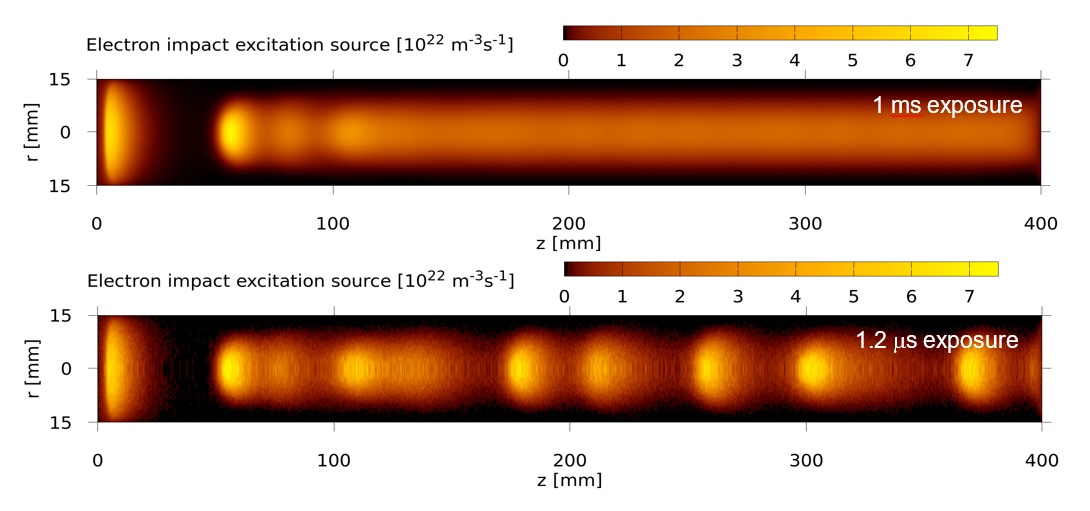
Figure 2. Electron impact excitation source from the PK-4 neon discharge simulation at long and short exposure times.
Reactive plasmas –
In the last decade plasma-activated water (PAW), or more generally plasma-activated liquid (PAL) has received a lot of attention from the plasma medicine and plasma agriculture community due to its potential to induce oxidative stress to cells. By PAL it is meant the liquid which contains reactive species, mostly reactive oxygen and nitrogen species (RONS), generated by the interaction of active or afterglow plasma with the liquid. PAW has been found to have antimicrobial and antibacterial effect, which is thought to occur due to the synergetic effect between the RONS and/or pH of the solution. Plasma activated buffered solution and cell culture media has also been studied for therapeutical aims, and it has been shown its potentials for cancer therapy. In the field of agriculture with PAW the improvement of seeds germination and plant growth have been targeted. The main long-lived RONS produced in PAL have been identified to be the H2O2 , NO2− and NO3−. The usual studies report typically one or two PAL conditions, giving no further suggestions for PAL composition tuning. In order to be able to identify the role of different species and to clarify the synergy effects in the interaction of PAL with biological systems, PAL with different compositions would be welcomed, in what concerns the density ratios of different RONS.
With our study we have shown the possibility of tunning the ratio of active species concentrations over three orders of magnitude in deionized water (DIW) activated with a surface-wave microwave discharge, see Figure 3, by varying the gas flow rate, initial gas mixture composition and treatment distance. The surface-wave microwave discharge is generated with the help of a surfatron launcher in a quartz tube of outer diameter 6 mm and inner diameter 4 mm using as a main gas Ar at gas flow rates of 1500 and 2000 sccm (Ar_x conditions in Figure 3). Ar-N2/O2 binary (ArN2_x and ArO2_x conditions) and ternary (ArN2O2_x conditions) mixtures are also used with the O2 and N2 gas flow rates ranging between 10-100 sccm. The input power is varied between 25 and 30 W, and the DIW is positioned below the plasma plume with the water surface being at d = 5.5 - 10.5 mm distance from the edge of the quartz tube, see Figure 4. By changing the mixture composition and the treatment distance, at the plume - water surface interaction point the electron density is changed, which determines the concentration of H2O2 created in the liquid phase.
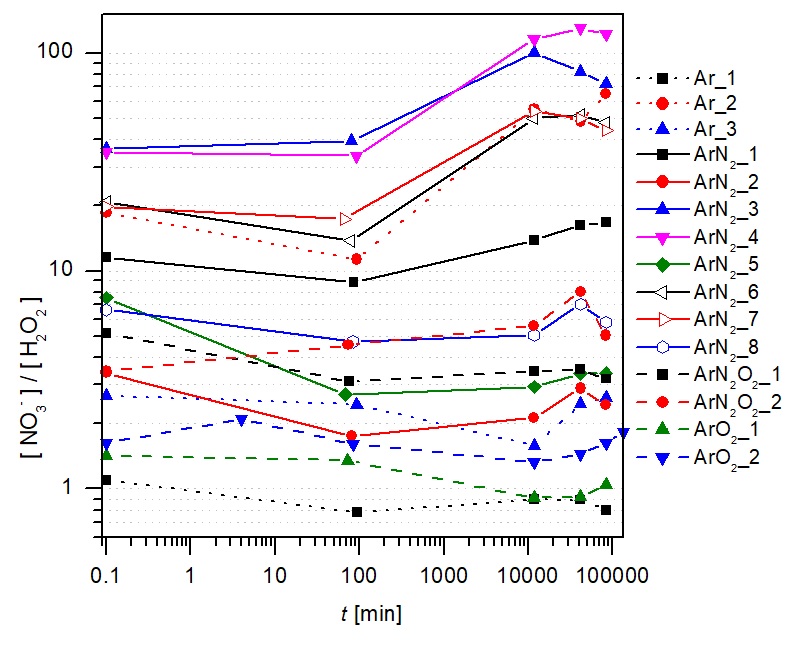
Figure 3. The ageing of the nitrate to hydrogen peroxide concentration ratio in the case of PAWs produced by Ar/N2/O2 surface-wave microwave discharges at different discharge and treatment conditions.
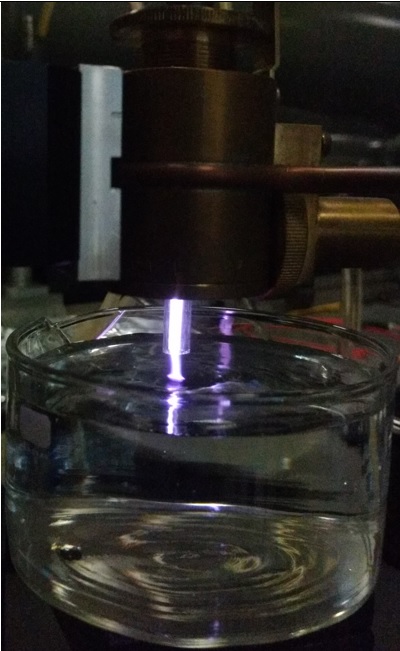
Figure 4. A surface-wave microwave discharge in interaction with water surface.

